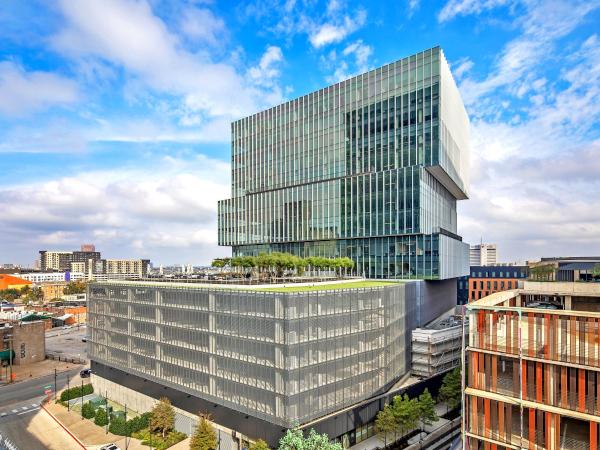
Date: 16 February 2023
Serving as an important bridge between the low-rise, pedestrian-scaled Deep Ellum historic neighborhood and Dallas’ downtown high-rises, the new Epic I office building is creatively stacked in two to five-story blocks to mediate the two urban scales.
To achieve a number of important objectives—including neutrality, energy performance and blending into the urban fabric—Perkins&Will, Dallas, selected Solarban® 90 Starphire® glass from Vitro Architectural Glass for the unitized curtainwall on all four elevations of the main tower and a smaller ground level retail section contains Solarban® 72 glass from Vitro Architectural Glass.
“The neutral color complements the materials of neighborhood storefronts and the project palette that consists of concrete, dark metal, and light grey metal lath,” explains Ron Stelmarski, FAIA, design director, Perkins&Will, Dallas. “The low solar heat gain coefficient (SHGC) was critical for meeting energy code while still allowing plenty of light into the building.”
Solarban® 90 glass conveys an appearance similar to clear glass in both color and reflectance whether viewed from the interior or exterior of a building. When combined in a standard one inch insulating glass unit (IGU) with Starphire Ultra-Clear® glass it delivers visible light transmittance (VLT) of 54% and SHGC of 0.23.
Fabricated by Oldcastle BuildingEnvelope ®, Wright City, Mo., and installed onto 5-in. by 10-in. curtainwall units with 5-in. by 4-in. transoms, the Solarban 90® Starphire® glass units are full vision glass, with the exception of a small band of shadowboxes at the bottom of each volume, to support increased light penetration into the interior spaces.
“The transparency helps connect the internal spaces with the neighborhood by providing visibility into the building to see the activity and spaces within,” says Kristin Winters, AIA, associate principal, Perkins&Will, Dallas.
Passersby are drawn to the unique, shifting-block façade, which energizes the building’s composition, creates upper-level outdoor terraces and captures energy savings for the LEED® gold-certified, 16-story office building through self-shading. In fact, these shifts are projected to trim the facility’s annual energy use by 5%.

The façade design also incorporates vertical fins and exterior mullion cap extensions for additional solar shading and visual depth and to dynamically reflect the sky’s changing conditions and the colors of sunrise and sunset.
“Using solar analysis software, we evaluated the specific needs for the massing overlaps and orientation to inform the variable depth of the fins ranging from four inches to 12 inches.,” explains Stelmarski.
Earning a Rethinking the Future 2020 runner-up award from RTF Architecture, the façade also features a lighted gasket to illuminate the soffits. “This vividly highlights the space between each dynamically stacked volume and creates an evening signpost for the area,” says Winters.
The neighboring Pittman Hotel, a recently completed adaptive reuse of the historic Knights of Pythias Temple with a modern addition, also features Solarban® 90 glass and Solarban® 72 glass punched windows throughout the masonry exterior.
Solarban® 72 glass delivers exceptional clarity and superior solar control performance, making it the ideal choice for the punched windows. In a standard one-inch IGU Solarban® 72 glass provides VLT of 68% and a solar heat gain coefficient of 0.28.
“Material details provide visual cohesion between Epic I and The Pittman Hotel,” relates Stelmarski. “Building envelopes achieved consistent depth through masonry detailing on Pittman and exterior shading fins on Epic I.”
The two projects demonstrate the successful integration of shifting urban densities between the two neighborhoods using architectural expression and materiality to look toward the future while still respecting the existing city fabric.
In weaving Deep Ellum into downtown Dallas, a “Cut” was also created next to Epic I as a direct vehicular and pedestrian link through the site between an adjacent public rail station and the existing, historic Elm Street storefronts and Pittman Hotel.
“The architecture of Epic I and the Pittman Hotel brackets this active streetscape and form a hinge between past and present toward a reimagined future,” observes Winters.
For more information about Solarban® 90, Starphire® and Solarban® 72 glasses and the rest of Vitro Glass’s full line of architectural glasses, visit www.vitroglazings.com.
 600450
600450






















Add new comment